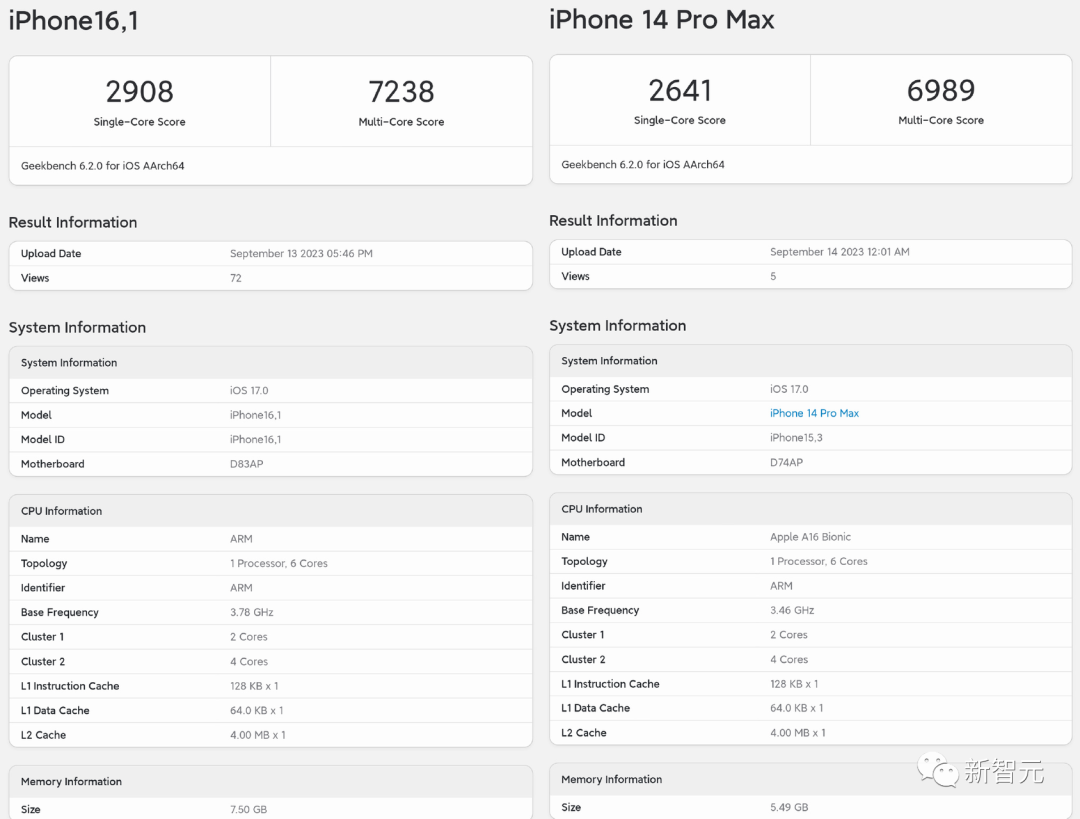Home >Technology peripherals >AI >Although it is 3nm, but squeeze out toothpaste? A17 Pro running scores released: CPU multi-core only increased by 3.6%
Although it is 3nm, but squeeze out toothpaste? A17 Pro running scores released: CPU multi-core only increased by 3.6%
- WBOYWBOYWBOYWBOYWBOYWBOYWBOYWBOYWBOYWBOYWBOYWBOYWBforward
- 2023-09-16 18:45:091124browse
As Apple A17 Pro was officially released yesterday, it uses a 3-nanometer process, but what is the performance like?

Multi-core single-digit improvement
The single-core performance of Apple A17 Pro on Geekbench 6 In terms of performance, it is 10% faster than its predecessor, the A16 Bionic.
Interestingly, the core frequency of A17 Pro is increased by about 10% compared to A16
In terms of multi-core performance, Apple A17 Pro The running score is about 7200 points, which is only 3% higher than the A16 Bionic
It makes people wonder whether Apple has made any micro-architectural improvements to the CPU in the latest SoC. Generating conjecture


Compared with Qualcomm’s Snapdragon 8 Gen 2, the A17 Pro’s single-core performance There is a large lead, close to 50%

Multi-core also leads by nearly 1/3.

The A17 Pro achieved a score of 2900 in the Geekbench 6 single-core test. This score is enough to compete with many desktop processors
Cross-border running scores, A17 Pro loses to Intel AMD flagship

In the Geekbench 6 benchmark test, the single-core performance of Apple’s latest A17 Pro Soc was less than 10% behind AMD’s Ryzen 9 7950X and Intel’s Core i9-13900K
However, the Apple A17 Pro has a frequency of 3.75 GHz, while Intel and AMD have almost twice the frequency of the A17 Pro, reaching 5.80 GHz and 6.0 GHz.
Apple’s A17 Pro SoC still uses a six-core configuration, which includes two high-performance cores with a frequency of 3.77 GHz, and four energy-saving cores that operate at a lower frequency

"Replacement Benchmark" scores, Apple increased by up to 70%
Time netizens calculated their own The iterative progress of Apple's chips since the A13 chip points out that Apple's innovation space has reached its limit

The CPU high core frequency of A12 Bionic (iPhone XS) is 2.49GHz, and the single-core performance reaches 1340 points
The CPU large-core frequency of A13 Bionic (iPhone 11) is increased to 2.66GHz (an increase of 6.8%), and the single-core performance reaches 1340 points 1790 points (an increase of 33.6%)
- A14 Bionic (iPhone 12), CPU large core frequency 2.99GHz (12.4%↑), single-core performance 2085 points (16.5%↑)
The CPU large core frequency of A15 Bionic (iPhone 13 Pro) is increased to 3.23GHz (an increase of 8%), and the single-core performance reaches 2416 points (an increase of 15.8%)
iPhone 14 Pro is equipped with the A16 Bionic chip. Its CPU large core frequency is increased to 3.46GHz (an increase of 7.1%), and the single-core performance reaches 2641 points (an increase of 9.3%)
The CPU large core frequency of A17 Pro (iPhone 15 Pro) is 3.78GHz (up 9.2%), and the single-core performance reaches 2908 points (up 10.1%)
It seems that the CPU has been squeezed out of a tube of toothpaste for five generations, and it has become less and less crowded.
The Snapdragon 8 Gen 3 is about to be launched, which may catch up with the shrinking trend of single-core and multi-core advantages

The situation with GPU is even more severe
Starting from A16, the generation gap between Apple and Qualcomm began to widen
Although it claims to have improved by 20% this year, the A17 Pro is still very likely to be beaten by the 8th and 3rd generations, and may not even catch up with the 8th and 2nd generations
For example, in terms of floating-point computing power, which tests GPU performance, A17 Pro lags behind 8 Gen 2 by nearly 70%.
Since the running scores of A17 Pro on CPU-Panda have not been tested after official release, they are marked as unreviewed

However, although the theoretical performance improvement is not big, Apple’s target users for this wave of replacements seem to be very clear – the main feature on the official website is a comparison with the iPhone 12 Pro.
Apple is reminding friends who are still using iPhone 12 that it is time to consider changing their phones!

The above is the detailed content of Although it is 3nm, but squeeze out toothpaste? A17 Pro running scores released: CPU multi-core only increased by 3.6%. For more information, please follow other related articles on the PHP Chinese website!

